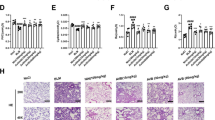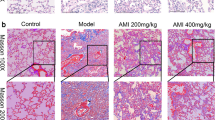Abstract
Idiopathic pulmonary fibrosis (IPF) is a progressive and irreversible lung disease with high mortality rate. The etiology is unknown and treatment choices are limited. Thus, there is great interest to investigate novel agents for IPF therapy. Ibrutinib, BTK, and ITK irreversible inhibitor is a FDA-approved small molecule for the clinical therapy of B cell lymphoma. Its role in pulmonary fibrosis remains unknown. In this study, we investigated the anti-fibrotic activity of ibrutinib. Strikingly, ibrutinib did not inhibit but exacerbated bleomycin-induced pulmonary fibrosis by increased epithelial cell apoptosis, and inflammation in the lung. The upregulated TGF-β and EMT transformation also contributes to enhanced myofibroblast differentiation and ECM deposition. Our findings reveal the detrimental effects of ibrutinib against bleomycin-mediated fibrosis and added to the understanding of IPF pathogenesis.







Similar content being viewed by others
References
Stowasser, S., and C. Hallmann. 2015. New guideline for idiopathic pulmonary fibrosis. Lancet 386 (10006): 1823–1824.
Raghu, G., H.R. Collard, J.J. Egan, et al. 2011. An official ATS/ERS/JRS/ALAT statement: idiopathic pulmonary fibrosis: evidence-based guidelines for diagnosis and management. American Journal of Respiratory and Critical Care Medicine 183 (6): 788–824.
Adamali, H.I., and T.M. Maher. 2012. Current and novel drug therapies for idiopathic pulmonary fibrosis. Drug Design, Development and Therapy 6: 261–272.
Travis, W.D., U. Costabel, D.M. Hansell, et al. 2013. An official American Thoracic Society/European Respiratory Society statement: update of the international multidisciplinary classification of the idiopathic interstitial pneumonias. American Journal of Respiratory and Critical Care Medicine 188 (6): 733–748.
Williamson, J.D., L.R. Sadofsky, and S.P. Hart. 2015. The pathogenesis of bleomycin-induced lung injury in animals and its applicability to human idiopathic pulmonary fibrosis. Experimental Lung Research 41 (2): 57–73.
Bringardner, B.D., C.P. Baran, T.D. Eubank, et al. 2008. The role of inflammation in the pathogenesis of idiopathic pulmonary fibrosis. Antioxidants & Redox Signaling 10 (2): 287–301.
Kolahian, S., I.E. Fernandez, O. Eickelberg, et al. 2016. Immune mechanisms in pulmonary fibrosis. American Journal of Respiratory Cell and Molecular Biology 55 (3): 309–322.
Satterthwaite, A.B., and O.N. Witte. 2000. The role of Bruton’s tyrosine kinase in B-cell development and function: a genetic perspective. Immunological Reviews 175: 120–127.
Rawlings, D.J., D.C. Saffran, S. Tsukada, et al. 1993. Mutation of unique region of Bruton’s tyrosine kinase in immunodeficient XID mice. Science 261 (5119): 358–361.
Maas, A., and R.W. Hendriks. 2001. Role of Bruton’s tyrosine kinase in B cell development. Developmental Immunology 8 (3–4): 171–181.
Dubovsky, J.A., K.A. Beckwith, G. Natarajan, et al. 2013. Ibrutinib is an irreversible molecular inhibitor of ITK driving a Th1-selective pressure in T lymphocytes. Blood 122 (15): 2539–2549.
Miller, A.T., H.M. Wilcox, Z. Lai, et al. 2004. Signaling through Itk promotes T helper 2 differentiation via negative regulation of T-bet. Immunity 21 (1): 67–80.
Gomez-Rodriguez, J., E.A. Wohlfert, R. Handon, et al. 2014. Itk-mediated integration of T cell receptor and cytokine signaling regulates the balance between Th17 and regulatory T cells. The Journal of Experimental Medicine 211 (3): 529–543.
Davis, R.E., V.N. Ngo, G. Lenz, et al. 2010. Chronic active B-cell-receptor signalling in diffuse large B-cell lymphoma. Nature 463 (7277): 88–92.
Kuppers, R. 2005. Mechanisms of B-cell lymphoma pathogenesis. Nature Reviews Cancer 5 (4): 251–262.
Byrd, J.C., J.R. Brown, S. O'Brien, et al. 2014. Ibrutinib versus ofatumumab in previously treated chronic lymphoid leukemia. The New England Journal of Medicine 371 (3): 213–223.
Barrientos, J., and K. Rai. 2013. Ibrutinib: a novel Bruton’s tyrosine kinase inhibitor with outstanding responses in patients with chronic lymphocytic leukemia. Leukemia & Lymphoma 54 (8): 1817–1820.
Brown, J.R., J.C. Barrientos, P.M. Barr, et al. 2015. The Bruton tyrosine kinase inhibitor ibrutinib with chemoimmunotherapy in patients with chronic lymphocytic leukemia. Blood 125 (19): 2915–2922.
Chang, B.Y., M.M. Huang, M. Francesco, et al. 2011. The Bruton tyrosine kinase inhibitor PCI-32765 ameliorates autoimmune arthritis by inhibition of multiple effector cells. Arthritis Research & Therapy 13 (4): R115.
Honigberg, L.A., A.M. Smith, M. Sirisawad, et al. 2010. The Bruton tyrosine kinase inhibitor PCI-32765 blocks B-cell activation and is efficacious in models of autoimmune disease and B-cell malignancy. Proceedings of the National Academy of Sciences of the United States of America 107 (29): 13075–13080.
Sagiv-Barfi, I., H.E. Kohrt, D.K. Czerwinski, et al. 2015. Therapeutic antitumor immunity by checkpoint blockade is enhanced by ibrutinib, an inhibitor of both BTK and ITK. Proceedings of the National Academy of Sciences of the United States of America 112 (9): E966–E972.
Schutt, S.D., J. Fu, H. Nguyen, et al. 2015. Inhibition of BTK and ITK with ibrutinib is effective in the prevention of chronic graft-versus-host disease in mice. PLoS One 10 (9): e0137641.
Dubovsky, J.A., R. Flynn, J. Du, et al. 2014. Ibrutinib treatment ameliorates murine chronic graft-versus-host disease. The Journal of Clinical Investigation 124 (11): 4867–4876.
Dong, Y., Y. Geng, L. Li, et al. 2015. Blocking follistatin-like 1 attenuates bleomycin-induced pulmonary fibrosis in mice. The Journal of Experimental Medicine 212 (2): 235–252.
Wang, Q., H. Li, Y. Yao, et al. 2010. The overexpression of heparin-binding epidermal growth factor is responsible for Th17-induced airway remodeling in an experimental asthma model. Journal of Immunology 185 (2): 834–841.
Wang, Q., H. Li, Y. Yao, et al. 2016. HB-EGF-promoted airway smooth muscle cells and their progenitor migration contribute to airway smooth muscle remodeling in asthmatic mouse. Journal of Immunology 196 (5): 2361–2367.
McGrath, E.E., and A.B. Millar. 2012. Hot off the breath: triple therapy for idiopathic pulmonary fibrosis—hear the PANTHER roar. Thorax 67 (2): 97–98.
King, T.E., Jr., W.Z. Bradford, S. Castro-Bernardini, et al. 2014. A phase 3 trial of pirfenidone in patients with idiopathic pulmonary fibrosis. The New England Journal of Medicine 370 (22): 2083–2092.
Richeldi, L., R.M. du Bois, G. Raghu, et al. 2014. Efficacy and safety of nintedanib in idiopathic pulmonary fibrosis. The New England Journal of Medicine 370 (22): 2071–2082.
Zhang, Z., X. Yu, X. Fang, et al. 2015. Preventive effects of vitamin D treatment on bleomycin-induced pulmonary fibrosis. Scientific Reports 5: 17638.
Kinder, B.W., K.K. Brown, M.I. Schwarz, et al. 2008. Baseline BAL neutrophilia predicts early mortality in idiopathic pulmonary fibrosis. Chest 133 (1): 226–232.
Obayashi, Y., I. Yamadori, J. Fujita, et al. 1997. The role of neutrophils in the pathogenesis of idiopathic pulmonary fibrosis. Chest 112 (5): 1338–1343.
Gregory, A.D., C.R. Kliment, H.E. Metz, et al. 2015. Neutrophil elastase promotes myofibroblast differentiation in lung fibrosis. Journal of Leukocyte Biology 98 (2): 143–152.
Chua, F., S.E. Dunsmore, P.H. Clingen, et al. 2007. Mice lacking neutrophil elastase are resistant to bleomycin-induced pulmonary fibrosis. The American Journal of Pathology 170 (1): 65–74.
Takemasa, A., Y. Ishii, and T. Fukuda. 2012. A neutrophil elastase inhibitor prevents bleomycin-induced pulmonary fibrosis in mice. The European Respiratory Journal 40 (6): 1475–1482.
Henry, M.T., K. McMahon, A.J. Mackarel, et al. 2002. Matrix metalloproteinases and tissue inhibitor of metalloproteinase-1 in sarcoidosis and IPF. The European Respiratory Journal 20 (5): 1220–1227.
Leask, A., and D.J. Abraham. 2004. TGF-beta signaling and the fibrotic response. FASEB Journal: Official Publication of the Federation of American Societies for Experimental Biology 18 (7): 816–827.
Gauldie, J., P.J. Sime, Z. Xing, et al. 1999. Transforming growth factor-beta gene transfer to the lung induces myofibroblast presence and pulmonary fibrosis. Current Topics in Pathology Ergebnisse der Pathologie 93: 35–45.
Bartram, U., and C.P. Speer. 2004. The role of transforming growth factor beta in lung development and disease. Chest 125 (2): 754–765.
Willis, B.C., and Z. Borok. 2007. TGF-beta-induced EMT: mechanisms and implications for fibrotic lung disease. American Journal of Physiology Lung Cellular and Molecular Physiology 293 (3): L525–L534.
Phan, S.H. 2002. The myofibroblast in pulmonary fibrosis. Chest 122 (6 Suppl): 286S–289S.
Hashimoto, N., S.H. Phan, K. Imaizumi, et al. 2010. Endothelial-mesenchymal transition in bleomycin-induced pulmonary fibrosis. American Journal of Respiratory Cell and Molecular Biology 43 (2): 161–172.
Tanjore, H., X.C. Xu, V.V. Polosukhin, et al. 2009. Contribution of epithelial-derived fibroblasts to bleomycin-induced lung fibrosis. American Journal of Respiratory and Critical Care Medicine 180 (7): 657–665.
Cappuccini, F., T. Eldh, D. Bruder, et al. 2011. New insights into the molecular pathology of radiation-induced pneumopathy. Radiotherapy and Oncology : Journal of the European Society for Therapeutic Radiology and Oncology 101 (1): 86–92.
Eferl, R., P. Hasselblatt, M. Rath, et al. 2008. Development of pulmonary fibrosis through a pathway involving the transcription factor Fra-2/AP-1. Proceedings of the National Academy of Sciences of the United States of America 105 (30): 10525–10530.
Strijbis, K., F.G. Tafesse, G.D. Fairn, et al. 2013. Bruton’s tyrosine kinase (BTK) and Vav1 contribute to Dectin1-dependent phagocytosis of Candida albicans in macrophages. PLoS Pathogens 9 (6): e1003446.
Ni Gabhann, J., E. Hams, S. Smith, et al. 2014. Btk regulates macrophage polarization in response to lipopolysaccharide. PLoS One 9 (1): e85834.
Mueller, H., A. Stadtmann, H. Van Aken, et al. 2010. Tyrosine kinase Btk regulates E-selectin-mediated integrin activation and neutrophil recruitment by controlling phospholipase C (PLC) gamma2 and PI3Kgamma pathways. Blood 115 (15): 3118–3127.
Khare, A., B. Viswanathan, R. Gund, et al. 2011. Role of Bruton’s tyrosine kinase in macrophage apoptosis. Apoptosis : An International Journal on Programmed Cell Death 16 (4): 334–346.
Gray P, Dunne A, Brikos C, et al. MyD88 adapter-like (Mal) is phosphorylated by Bruton's tyrosine kinase during TLR2 and TLR4 signal transduction. The Journal of biological chemistry 2006;281(15):10489-10495.
Rushworth SA, Bowles KM, Barrera LN, et al. BTK inhibitor ibrutinib is cytotoxic to myeloma and potently enhances bortezomib and lenalidomide activities through NF-kappaB. Cellular signalling 2013;25(1):106-112.
Honda F, Kano H, Kanegane H, et al. The kinase Btk negatively regulates the production of reactive oxygen species and stimulation-induced apoptosis in human neutrophils. Nature immunology 2012;13(4):369-378.
Islam TC, Smith CI. The cellular phenotype conditions Btk for cell survival or apoptosis signaling. Immunological reviews 2000;178:49-63.
Khare A, Viswanathan B, Gund R, et al. Role of Bruton's tyrosine kinase in macrophage apoptosis. Apoptosis : an international journal on programmed cell death 2011;16(4):334-346.
Funding
This work was supported by research funding from the National Natural Science Foundation of China (81170015) and Zhejiang Provincial Natural Science Foundation of China (LY15H010001).
Author information
Authors and Affiliations
Contributions
Author Contributions
Conception and design of research: H.L.; performed the experiments: Y.G., B.H., Y.Y., M.Q., G.L.; analyzed the data and interpreted the results of experiments: Y.G., B.H., H.L.; prepared the figures and drafted the manuscript: Y.G., B.H., Y.Y., M.Q., H.L.; edited and revised the manuscript: Y.G., D.X., H.L
Corresponding author
Ethics declarations
Conflict of Interest
The authors declare that they have no conflict of interest.
Rights and permissions
About this article
Cite this article
Gu, Y., Huang, B., Yang, Y. et al. Ibrutinib Exacerbates Bleomycin-Induced Pulmonary Fibrosis via Promoting Inflammation. Inflammation 41, 904–913 (2018). https://doi.org/10.1007/s10753-018-0745-3
Published:
Issue Date:
DOI: https://doi.org/10.1007/s10753-018-0745-3




